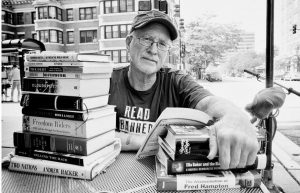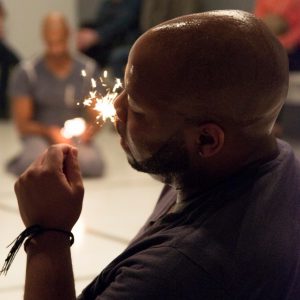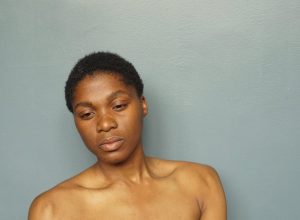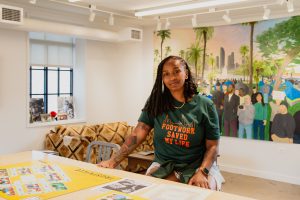Movement Matters investigates work at the intersection of dance, performance, politics, policy and issues related to the body as the locus of these and related socio-cultural dialogues on race, gender, ability and more. For this installment, we sit down with Jenai Cutcher West, Director of the Chicago Dance History Project to discuss the state of the nascent organization, her vision and long term aspirations for preserving Chicago’s contribution to the regional and international dialogue around dance.
Michael Workman: You’re the Executive Director of the Chicago Dance History Project.
Jean Cutcher West: It’s the first time I applied for a job the old-fashioned way, and I got it. I wasn’t living in Chicago, but a friend sent me the job posting and it worked out. I moved here for this. Before me, a group of local Chicago dancers, advocates and scholars were getting together formally, I think somewhat regularly and decided that this was a worthy project and it was time to get started on it.
MW: It’s an interesting thing, people just don’t know what’s happened in Chicago.
JCW: Right and that’s our mission, first and foremost is to research the dance histories that are here, honor the national and international touring companies that have sprung from here as well as surfacing and shining more light on the local and regional dance companies. And I think, without calling attention to the second city syndrome, we want to write Chicago dance into the national and international discussions of dance history.
MW: What do you mean, “write them in?”
JCW: Well, study Modern dance history at any college or university, my guess is that 95% of the dance curriculum will be based in New York. But there’s more Modern dance than what comes out of New York.
MW: I think there’s some question about that, are you going to see work in Chicago that pushes back against the canon?
JCW: Well, what’s the canon? It is part of the canon. I think that’s what we’re saying. It is pushing and challenging the canon because it’s a part of it. It’s not outside the canon. And I think that’s the mistake, in tending to think the canon is something other.
MW: How much of that mission then is also about changing the present?
JWC: I don’t think you can avoid changing the present. I think what you do doesn’t exist in a vacuum. At least this point, we’re not interested in curating or saying what is Chicago dance history. We’re investigating, learning and invite others to join us in that.
MW: So the organization is in more of a research mode?
JCW: Definitely. We’re gathering information, trying to be as inclusive as possible, but not without an eye for the future. We think that looks like building a digital archive. We’re collecting oral history interviews on-camera, so that’s going to form the basis of it. And again, that’s ideally going to be as inclusive as possible. But from that digital archive—we fully expect to do this ourselves, but invite others to do the same—is to go in and create more specific narratives in a variety of media. Then we’ll really get into the interpreting, narrating and postulating. But for the first three years our primary focus is research, gathering information, collecting oral history interviews. Hosting events, panel discussions.
MW: How did you initially get involved in dance?
JCW: I came to dance in college as an undergrad. I was an English major, so I always looked at dance through the window of writing. But very quickly I became a professional dancer in New York supporting myself as a freelance writer for the Village Voice and Dance Magazine. So, writing has always been a component, as has singing, teaching and performing as well. And then, shortly after I started performing as a tap dancer, I realized I had a lot of questions about the history of tap dance and I decided to investigate those questions by making a documentary film. So that was how I acquired some documentary skills—and I mention it because I realize that those skills come into play in the job. It’s probably the only job ever that utilizes all of my skills. My background in dance is in tap dance, primarily, and then writing, filmmaking and research. I started writing in Columbus, Ohio, so I was writing about whatever dance was happening in Columbus. But then when I got to New York, I wrote for various online publications, again, mostly about anything. A lot of dance writers are well-informed on a general level, but when it comes to writing specifically about tap dance, perhaps find themselves a bit at a loss.
MW: Maybe that’s something of the Chicago Dance History Project, is to write a history that hasn’t been recorded yet?
JCW: I’m actually not going to think about it that way. I think it’s too—I think it’s a little presumptuous that any one of us or the group of us is writing a first draft of history. Right now, I’m thinking of it as making stories from folks in the Chicago dance community accessible, in their own words.
MW: Right, well that’s certainly different from a dance critic’s mission.
JCW: Exactly. And again, those specific narratives are going to be crafted further down the road.
MW: What do you find you are personally finding interesting about Chicago dance history, as you’re learning about it?
JCW: I’m really interested in what people think makes it distinct. It’s something that’s probably hard to pin down no matter what the specifics, but everybody does agree that there is a character here that’s distinctly Chicagoan, and I like asking people to try and define what that is.
MW: What are you hearing?
JCW: I would say the most common answer, in one form or another, is luck. And work ethic. The process of it is what people here are more concerned with and focused on and able to speak more intelligently about. We’re looking, too, to figure out how dance has shaped Chicago and vice-versa. Personally, I’m drawn to a lot of the civic institutions who have supported dance here—again, as you said, it’s a very different ballgame in terms of dance public programming. I think the process between relationships may be different too. It’s because, in part, because of sheer numbers.
MW: Yes, there’s a lot of potentially forgotten Chicago dance history, too, around efforts like MoMing, that was important, and critical to the international conversation around dance.
JCW: Oh, absolutely. That’s partially what this project is about. I had a similar experience: I started dancing in undergrad at Ohio State then 6 or 7 years after that I went back to get a grad degree in dance but neither time—and it’s a fantastic dance program—but at no point in my education there in the Midwest did I hear of MoMing, or Sybil Shearer for that matter. Of course I’ve heard of Judson, so when I realized that, I came to this job knowing very little about Chicago dance history. So it’s a huge learning curve for me too. Discovering Sybil Shearer and the incredible contributions she made to the dance canon, MoMing and the list goes on and on, I had that thought too. How could I not know about these people? Especially considering I study dance in the Midwest. Somebody said to me recently, I don’t remember who, but they said Chicago audiences are funny, they won’t know to like something unless it passed muster in New York. Something to that effect.
MW: Right, there’s this base admiration of the culture of the gentry. Unfortunately, it’s like that in many art forms, it’s more about the class status than the ideas. But then there’s also this lunkheaded view of dance as a lesser art form, as somehow secondary to, say, visual art.
JCW: Yes, that’s not specific to Chicago. It doesn’t get as much attention or funding or whatever you want to say compared to the other arts. But it’s also the hardest one to historicize, to write about, to preserve and pass the legacy on. It’s an embodied experience. It happens from one person to the next in a studio, or in a conversation like this. So, I think what we’re trying to do is just help the oral history process along. It’s already there. I think we’re just being a little bit more proactive about it and opening the audience for that oral history, making it more accessible. So you don’t necessarily have to be in the room or the studio to get some of the information. I’m not saying all of it. Right now we’re researching the history of the early 20th century. We started with the elders in the community, those performances have come and gone. We’re looking to add something to what’s already out there and that something, we’ve concluded are oral history interviews. People getting to tell their stories for the first time in a long time, if not ever. Films of performances, records and other kinds of archives are scattered throughout the city in incredible collections and we would like to make more people aware of those collections so we don’t have to do that work. We would like to create an avenue and a portal for interested audiences to get to the Newberry [Library] or the DuSable [Museum of African American History] or the Chicago Public Library to watch videos, for example. I think then you could think of the Chicago Dance History Project as supplementing all the other collections that already exist and continue to grow. The raw footage of the oral history interviews will eventually be housed at the Newberry. We’re going to use them, in an edited form, to build a digital archive.
MW: It’s an expansive program.
JCW: So far as I know, I haven’t come across a similar model. So we’re figuring it out as we go; I do want to gather as many interviews as humanly possible. Hopefully, we can get to the point with staff and interviewers where we can handle something like a call to participate, but for now it’s just me and volunteer crew, when they’re available. We’re trying very hard to prioritize elders, but just like anything else it’s dictated to some degree by logistics, you know, hey this person is in town for 3 days over Thanksgiving and he lives on the est cost so even though he’s not an elder, I’m going to interview him now. So, there’s been a little bit of that as well. One by one.
More information at chicagodancehistory.org.
Please feel free to send questions, comments or tips to Michael Workman at michael.workman1@gmail.com. As part of the Movement Matters series, a monthly online conversation on subjects discussed in the column will take place starting with The Integral Necessity of Dance Criticism on Dec. 15, 6:30-9:30pm at High Concept Laboratories (2233 S. Throop St., Chicago). Please join the Movement Matters Facebook page for updates, and to join in on future online conversations.
Featured Image by William Frederking.
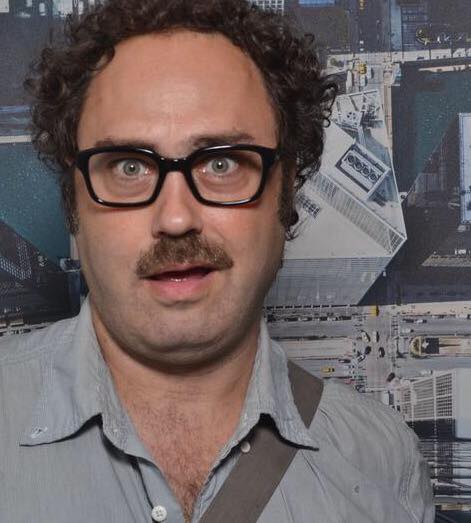 Michael Workman is an artist, writer, dance, performance art and sociocultural critic, theorist, dramaturge, choreographer, reporter, poet, novelist and curator of numerous art, literary and theatrical productions over the years. In addition to his work at The Guardian US, Newcity, Sixty and elsewhere, Workman has also served as a reporter for WBEZ Chicago Public Radio, and as Chicago correspondent for Italian art magazine Flash Art. He is also Director of Bridge, a Chicago-based 501 c (3) publishing and programming organization. You can follow his daily antics on Facebook.
Michael Workman is an artist, writer, dance, performance art and sociocultural critic, theorist, dramaturge, choreographer, reporter, poet, novelist and curator of numerous art, literary and theatrical productions over the years. In addition to his work at The Guardian US, Newcity, Sixty and elsewhere, Workman has also served as a reporter for WBEZ Chicago Public Radio, and as Chicago correspondent for Italian art magazine Flash Art. He is also Director of Bridge, a Chicago-based 501 c (3) publishing and programming organization. You can follow his daily antics on Facebook.

